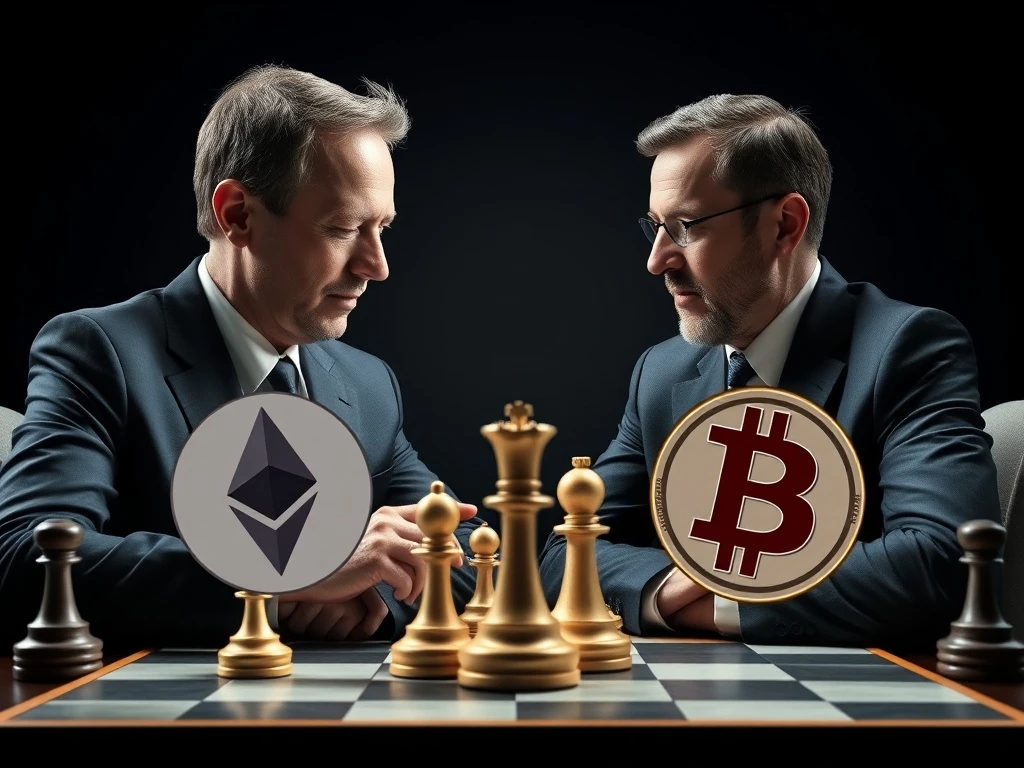Unlocking Value: Peter Thiel vs. Michael Saylor’s Astute Crypto Treasury Strategy Bets

In the dynamic world of digital assets, understanding the evolving crypto treasury strategy is crucial. Two titans of finance, Peter Thiel and Michael Saylor, have adopted vastly different, yet equally ambitious, approaches to integrating cryptocurrencies into their corporate treasuries. Their contrasting philosophies offer valuable insights into the future of institutional crypto adoption. This article delves into their distinct strategies, comparing their methods, chosen assets, and potential long-term implications for the market.
Peter Thiel’s Astute Ethereum Investment Strategy
Peter Thiel, a visionary investor and co-founder of PayPal and Palantir, approaches crypto exposure with a strategic, indirect lens. He has quietly built a significant footprint in crypto treasuries by backing companies that focus on Ethereum investment. This method provides him substantial indirect exposure to Ethereum’s growth, aligning perfectly with his broader venture capital philosophy.
Thiel’s strategy involves taking significant stakes in companies that pivot to become Ether-treasury vehicles. Consequently, he captures both equity upside and crypto-treasury exposure. This is the same asymmetric playbook he successfully utilized with early investments in Facebook and Palantir. Furthermore, Thiel views Ether (ETH) as programmable capital, essential for new financial infrastructure, rather than solely a store of value.
The Mechanics of Thiel’s Indirect Exposure
Thiel, through his investment funds, has supported entities like ETHZilla and BitMine Immersion. These firms subsequently transformed into substantial Ether-holding entities. For instance, ETHZilla, formerly Nasdaq-listed 180 Life Sciences, announced a $425-million private investment to build an Ether treasury. It also secured approval to issue another $150 million in debt securities, with Electric Capital managing its on-chain yield programs. Similarly, BitMine has raised hundreds of millions, accumulating over 1.52 million ETH, valued at approximately $6.6 billion, including 373,000 tokens added during Ether’s recent resurgence.
By investing in these companies rather than directly purchasing Ether, Thiel achieves a unique advantage. He avoids the direct custody and regulatory complexities associated with holding ETH. Instead, his capital is embedded in firms that can potentially rally markets and compound gains as Ether becomes more integrated into financial rails. This positions him within the ecosystem where tokenized finance and decentralized finance (DeFi) infrastructure are actively developing.
Did you know? Peter Thiel co-founded Bullish, a cryptocurrency exchange launched in 2021. Valued at over $7 billion at the time, it raised $1.1 billion in its initial public offering. Bullish aims to convert much of that capital into stablecoins, indicating a broader institutional treasury shift toward crypto-native liquidity systems.
Michael Saylor’s Unwavering Bitcoin Accumulation
Michael Saylor has undeniably become the public face of corporate Bitcoin adoption. He transformed MicroStrategy, a conventional software company, into the world’s largest corporate Bitcoin accumulation vehicle. Saylor’s conviction stems from his belief in Bitcoin as a superior reserve asset and a robust hedge against fiat inflation.
Saylor’s strategy is remarkably straightforward yet bold: MicroStrategy systematically uses equity offerings, preferred stock, and occasional debt to raise capital. This capital is then converted into Bitcoin (BTC). According to BitcoinTreasuries.net, as of August 2025 (as per the original source’s projection), MicroStrategy holds approximately 629,000 BTC. This represents nearly 64% of all public-company treasury holdings, showcasing their dominant position.
The Consistency of Saylor’s Bitcoin Strategy
Under Saylor’s guidance, MicroStrategy maintains a consistent accumulation policy, irrespective of market volatility. They finance these purchases through innovative tools such as at-the-market equity sales, perpetual preferred stock, and convertible debt. For example, to mark five years of Bitcoin adoption, the company reportedly purchased over 585 BTC for $69 million in August 2025 alone. These actions underscore Saylor’s steadfast dedication to building a company balance sheet centered around Bitcoin as a structural asset, even amidst market uncertainties.
Saylor’s relentless buying has significantly normalized the concept of corporations holding Bitcoin as a primary treasury reserve. MicroStrategy’s reliance on over-the-counter (OTC) desks helps minimize market slippage and avoids price shocks, despite holding close to 3% of Bitcoin’s total supply. The outcome is a treasury model that appears predictable, transparent, and designed for decades of steady accumulation.
Contrasting Crypto Treasury Strategy Approaches
At first glance, both Michael Saylor and Peter Thiel pursue a similar objective: leveraging crypto as a treasury reserve to generate long-term value. However, their methods, chosen assets, and underlying philosophies diverge sharply. This comparison highlights the varied pathways to institutional crypto adoption and offers a deeper understanding of the evolving crypto treasury strategy landscape.
Here is a breakdown of their key differences:
- Asset Focus: Saylor exclusively targets Bitcoin (BTC), viewing it as digital gold and a store of value. Thiel, conversely, focuses on Ethereum (ETH), recognizing its potential as programmable capital and the foundation for decentralized applications.
- Exposure Method: Saylor’s approach involves direct ownership and holding of BTC on MicroStrategy’s balance sheet. Thiel’s strategy is indirect, investing in companies that themselves become Ether treasury vehicles, thus gaining equity and crypto exposure.
- Philosophical Underpinnings: Saylor emphasizes Bitcoin’s scarcity and its role as an inflation hedge. Thiel highlights Ethereum’s utility, its ecosystem for innovation, and its long-term optionality in building new financial infrastructure.
- Capital Deployment: MicroStrategy employs a consistent, cost-averaging strategy, using various financing instruments to steadily acquire Bitcoin. Thiel’s method involves strategic venture capital investments, identifying undervalued firms and guiding their pivot towards Ether treasuries.
- Liquidity and Flexibility: Saylor’s BTC holdings are largely locked on MicroStrategy’s balance sheet, intended for long-term hold. Thiel retains more flexibility, as he can adjust his positions by shifting equity stakes in the ETH-treasury firms he backs.
- Risk Profile: Saylor’s direct BTC exposure carries market price risk, but his consistent accumulation mitigates timing risk. Thiel’s indirect exposure introduces additional layers of corporate governance and execution risk, alongside ETH price volatility.
Evaluating the Smarter Crypto Treasury Bet
When comparing Peter Thiel’s and Michael Saylor’s treasury strategies, the distinction lies as much in their philosophical underpinnings as in their execution. Both have secured sizable positions in the crypto market, but they achieve this exposure through fundamentally different means, creating distinct risk-reward profiles for their respective crypto treasury strategy.
Peter Thiel’s Strategic Agility in Focus
Thiel’s approach emphasizes strategic agility, allowing him to capture asymmetric upside without directly holding ETH. This method leverages his extensive venture capital background, enabling him to identify firms with significant optionality and scalable upside. These companies can then compound gains as ETH becomes more deeply embedded in global financial systems.
- Capital Deployment Flexibility: Thiel can rapidly deploy large capital into companies demonstrating strong upside potential post-pivot. This benefits from coordinated token accumulation and subsequent stock price rerating.
- VC Background Advantage: His experience allows him to seek out firms with high optionality and the potential for substantial returns if Ethereum’s role in financial rails expands.
- Indirect Exposure Benefits: While this strategy introduces reliance on management execution and potentially thinner liquidity in some targets, it crucially avoids direct custody or specific regulatory exposure to ETH itself. The upside potential, however, is significant.
Michael Saylor’s Process and Consistency
Saylor’s advantage comes from his unwavering process and consistency, rather than speculative market timing. His strategy prioritizes long-term accumulation and balance-sheet strength, making it highly transparent and predictable for investors.
- Cost-Averaging Principle: Regular, systematic purchases smooth out price volatility over time. This creates a powerful long-term accumulation advantage, reducing the impact of short-term market fluctuations.
- Layered Financing Model: MicroStrategy uses a sophisticated mix of equity, preferred shares, and convertible debt. This sustainably funds new purchases, even when the company’s market-to-net-asset-value premium (mNAV) might fluctuate.
- Scale and Transparency: The model is highly visible to investors, regulators, and the broader market. This signals immense confidence and an unwavering commitment to Bitcoin as a core treasury reserve asset.
Future Implications for Bitcoin Accumulation and Ethereum Investment
Both Thiel’s and Saylor’s strategies create significant ripple effects across the institutional crypto landscape. Saylor’s relentless Bitcoin accumulation has undeniably normalized the concept of corporations holding BTC as a primary treasury reserve. This precedent has opened doors for other public companies to consider similar strategies, solidifying Bitcoin’s status as a legitimate asset class for corporate balance sheets.
Conversely, Thiel’s strategic pivots into Ether treasuries are establishing a similar precedent on the Ethereum side. He demonstrates that public companies can restructure themselves entirely around crypto holdings, specifically leveraging Ether’s utility and ecosystem. Where Saylor exemplifies scale and conviction in a singular asset, Thiel showcases agility and innovation by targeting the broader potential of the Ethereum network.
The long-term implications are profound. Saylor’s model suggests a future where Bitcoin acts as a foundational, unshakeable reserve asset for numerous corporations. Thiel’s strategy points towards a future where Ethereum powers a new, tokenized financial system, attracting venture capital and corporate restructuring around its programmable capabilities. Both approaches validate the growing importance of digital assets in mainstream finance, albeit through different lenses.
Conclusion: Two Paths to Crypto Success
Ultimately, determining the ‘smarter’ bet depends on an organization’s strategic goals and risk appetite. For a scalable, transparent, and long-term treasury build-out focused on digital scarcity, Saylor’s model of direct Bitcoin accumulation stands as a robust choice. His methodical approach prioritizes stability and clear communication to investors.
However, for higher-beta, venture-style upside, especially for those riding macro momentum in Ether’s utility and ecosystem development, Thiel’s indirect Ethereum investment approach may yield outsized returns. His strategy leverages market realignment and the transformative potential of programmable money. The contrast is clear: one strategy builds an impregnable fortress of reserves, while the other rides waves of institutional realignment and innovation. Both, in their unique ways, are shaping the future of corporate crypto engagement.







